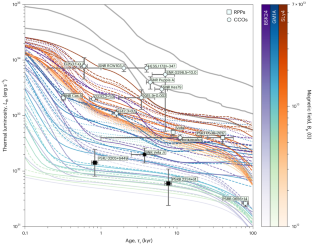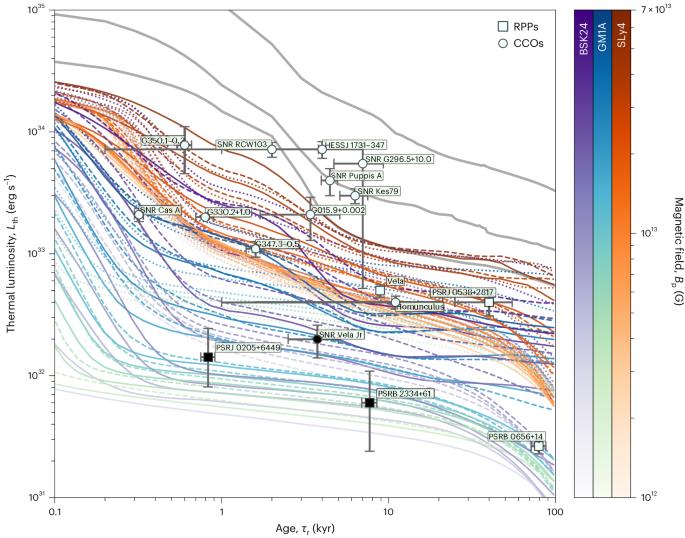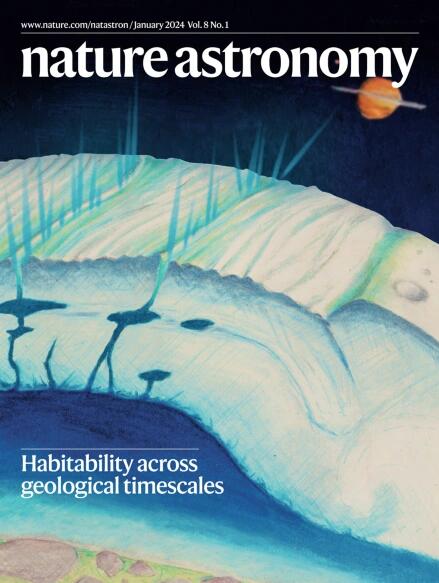来自年轻和寒冷孤立中子星的致密物质状态方程约束
IF 12.9
1区 物理与天体物理
Q1 ASTRONOMY & ASTROPHYSICS
引用次数: 0
摘要
中子星是大质量恒星超新星爆炸的致密高磁遗迹。探索超致密物质的状态方程(EOS),从而探测中子星内部物质的行为,是现代物理学和天体物理学的核心目标之一。一种很有前途的方法是研究中子星的长期冷却,将理论预测与不同年龄的各种来源进行比较。然而,有限的观测数据以及源年龄和距离的不确定性阻碍了这一方法的实施。在这里,通过重新分析来自数十颗热辐射孤立中子星的XMM-牛顿和钱德拉数据,我们发现了三个表面温度出乎意料地低的年轻中子星源。为了研究这些异常现象,我们对不同质量和磁场的中子星进行了磁热模拟,并考虑了三种不同的EOS。我们发现,无论质量和磁场如何,"最小 "冷却模型都无法解释观测结果,机器学习分类方法也验证了这一点。这些年轻冷中子星的存在表明,至少在某些质量范围内,任何致密物质的EOS都必须与快速冷却过程相兼容,根据最近的元建模分析,目前的EOS选择有很大一部分被排除了。本文章由计算机程序翻译,如有差异,请以英文原文为准。


Constraints on the dense matter equation of state from young and cold isolated neutron stars
Neutron stars are the dense and highly magnetic relics of supernova explosions of massive stars. The quest to constrain the equation of state (EOS) of ultradense matter and thereby probe the behaviour of matter inside neutron stars is one of the core goals of modern physics and astrophysics. A promising method involves investigating the long-term cooling of neutron stars, comparing theoretical predictions with various sources at different ages. However, limited observational data, and uncertainties in source ages and distances, have hindered this approach. Here, by re-analysing XMM-Newton and Chandra data from dozens of thermally emitting isolated neutron stars, we have identified three sources with unexpectedly cold surface temperatures for their young ages. To investigate these anomalies, we conducted magneto-thermal simulations across diverse mass and magnetic fields, considering three different EOSs. We found that the ’minimal’ cooling model failed to explain the observations, regardless of the mass and the magnetic field, as validated by a machine learning classification method. The existence of these young cold neutron stars suggests that any dense matter EOS must be compatible with a fast cooling process at least in certain mass ranges, eliminating a significant portion of current EOS options according to recent meta-modelling analysis. The quest to understand the composition of neutron stars is a major challenge of modern physics. Here three isolated, young and cold neutron stars have been identified, showing how extremely dense matter can cool rapidly after a supernova explosion.
求助全文
通过发布文献求助,成功后即可免费获取论文全文。
去求助
来源期刊

Nature Astronomy
Physics and Astronomy-Astronomy and Astrophysics
CiteScore
19.50
自引率
2.80%
发文量
252
期刊介绍:
Nature Astronomy, the oldest science, has played a significant role in the history of Nature. Throughout the years, pioneering discoveries such as the first quasar, exoplanet, and understanding of spiral nebulae have been reported in the journal. With the introduction of Nature Astronomy, the field now receives expanded coverage, welcoming research in astronomy, astrophysics, and planetary science. The primary objective is to encourage closer collaboration among researchers in these related areas.
Similar to other journals under the Nature brand, Nature Astronomy boasts a devoted team of professional editors, ensuring fairness and rigorous peer-review processes. The journal maintains high standards in copy-editing and production, ensuring timely publication and editorial independence.
In addition to original research, Nature Astronomy publishes a wide range of content, including Comments, Reviews, News and Views, Features, and Correspondence. This diverse collection covers various disciplines within astronomy and includes contributions from a diverse range of voices.
 求助内容:
求助内容: 应助结果提醒方式:
应助结果提醒方式:


